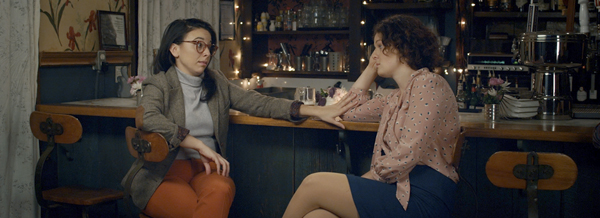Sharp, yet ultimately poignant, Dim the Fluorescents won the Grand Jury Prize for Best Narrative Feature at the recent Slamdance Film Festival. It centers on two creative people still waiting for their big break to materialize: Audrey (Claire Armstrong), an actress who has done her share of auditions, but whose agent hasn’t been calling her much lately; and Lillian (Naomi Skwarna), a writer. Though disciplined in her approach, she will only show her work to Audrey.
The two are friends, roommates, and creative partners who collaborate on one-acts at corporate events, where they dramatize the importance of workplace safety and preventing sexual harassment. When we first meet them, they’ve already done a few of these, and are soon offered their most lucrative gig yet for a leadership-themed conference. Lillian points out that the duo will have their largest audience to date, but Audrey is concerned that they’re not challenging themselves enough.
The screenplay, by director Daniel Warth and co-writer Miles Barstead, touches on a lot of different topics, starting with the realities of women in their 30s trying to make it in the entertainment world. Audrey has reached the point where a lack of callbacks isn’t the problem; she isn’t even getting auditions. Meanwhile, the outlook isn’t considerably better for Lillian, although there is at least the possibility of making industry contacts through a former classmate turned successful playwright.
The film is a dark comedy—the workplace-safety performance ends on a note of spectacle worthy of Brian De Palma—and has elements of show business satire. During a routine meeting with an unsuspecting corporate lackey, Audrey and Lillian demand final script approval and complementary tickets. But above all, it explores the intense dynamic between its two leads. We get a sense of it early on. Following a performance, they go out to a bar to celebrate. Audrey goes home with a man, but Lillian isn’t aware of it until she looks up and sees her partner is gone.
Is Lillian in love with Audrey? It’s possible, or it might just be that after working for so long with only her, she’s grown so reliant on Audrey, and so the idea of taking on different collaborators is impossible to entertain. Unfortunately for poor Lillian, Audrey’s own commitment is starting to waver. She is considering quitting acting altogether, and has become more than a little distracted by Bradley (Brendan Hobin), an office worker. Although he seems decent, he might be looking for someone more conventional. Both Audrey and Lillian, however, are ultimately tragic figures. Opportunities to build relationships outside of their two-person universe repeatedly present themselves, and at least in Lillian’s case, her automatic response is to pass on them.
Dim the Fluorescents takes an even-handed approach to life inside the twosome’s protective bubble. When they are focused on a task, they are a dynamo of productivity. They toss ideas back-and-forth rapidly, practically finish each other’s sentences, and literally run seemingly in lockstep. It’s also clear they produce powerful theatre, judging by the reactions of those who see it.
But the film also indicates that once Audrey and Lillian are outside of the bubble, their confidence largely vanishes, in no small part because the larger world reminds them what tiny fish they are. During a party sequence, in which they’re surrounded by people who seemingly have gone further with their own artistic careers, Warth frames his protagonists’ faces from ever-closer angles, revealing their growing sense of unease gradually.
A little more than halfway through, the film does something unexpected by splitting up its duo, as well as disrupting the linear narrative, to follow each of them individually across the same crucial stretch of time. It’s a decision that might seem extraneous, but it explores just how deep the co-dependent relationship runs.
Overall, Dim the Fluorescents is a thoughtful film with relatable characters (the idea of having to compromise on one’s dreams for a paycheck should even be applicable to those who aren’t aspiring thespians or playwrights), strong writing, and engaging performances. The ending is challenging but highly theatrical, too. It’s the kind of production that in their ideal world, Audrey and Lillian would get to do all the time.







Leave A Comment